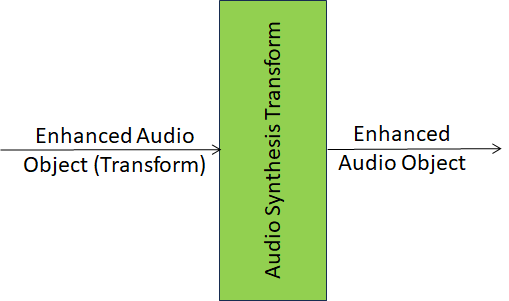| 1 Function | 2 Reference Model | 3 Input/Output Data |
| 4 SubAIMs | 5 JSON Metadata | 6 Profiles |
| 7 Reference Software | 8 Conformance Texting | 9 Performance Assessment |
1 Functions
Audio Synthesis Transform (CAE-AST):
| Receives | Enhanced Audio Object (Transform) | with associated Microphone Array info. |
| Transforms | Enhanced Audio Object (Transform) | from the frequency domain to the time domain via an Inverse Fast Fourier Transform (IFFT). |
| Produces | Enhanced Audio Object | with associated Microphone Array info. |
2 Reference Model
Figure 1 depicts the Reference Architecture of the Audio Synthesis Transform (CAE-AST) AIM.

Figure 1 – The Audio Synthesis Transform (CAE-AST) AIM
3 Input/Output Data
Table 1 specifies the Input and Output Data of the Audio Synthesis Transform (CAE-AST) AIM.
Table 1 – I/O Data of Synthesis Transform (CAE-AST) AIM
| Input | Description |
| Enhanced Audio Objects | Audio Objects in the time-frequency domain. |
| Output | Description |
| Enhanced Audio Objects | Audio Objects in the time domain. |
4 SubAIMs
No SubAIMs.
5 JSON Metadata
https://schemas.mpai.community/CAE1/V2.3/AIMs/AudioSynthesisTransform.json
6 Profiles
No Profiles.
7 Reference Software
8 Conformance Testing
The following steps shall be followed when testing the Conformance of a CAE-AAT AIM instance.
- Use the following datasets
- DS1: n Test files including data in Enhanced Audio Objects (Transform).
- DS2: n Expected Output files including data in Enhanced Audio Objects.
- Feed the AIM under test with the Enhanced Audio Objects (Transform) Test files (DS1).
- Analyse the Enhanced Audio Objects with the Expected Enhanced Audio Objects (DS2) with the following steps:
- Check the Enhanced Audio Objects data format with the given Expected Enhanced Audio Objects format.
- Calculate the peak-to-peak Amplitude (A) of each Audio block in the Expected Enhanced Audio Objects.
- Calculate the RMSE of each Audio block by comparing the output (x) with the Expected Enhanced Audio Objects (y) Audio blocks.
- Accept the AIM under test if, for each audio block, these the two conditions are satisfied:
- Data format of the Enhanced Audio Objects is the same with the Expected Enhanced Audio Objects and
- RMSE < A* 0.1%
- The Conformance Tester will provide the following matrix with a limited number of input records (n) with the corresponding outputs. If an input record fails, the tester would specify the reason why the test case fails.
| Input data (DS1) | Expected Output Data (DS2) | Data Format | RMSE |
| Enhanced Audio Objects ID1 | Enhanced Audio Objects ID1 | T/F | < A* 0.1% |
| Enhanced Audio Objects ID2 | Enhanced Audio Objects ID2 | T/F | < A* 0.1% |
| Enhanced Audio Objects ID3 | Enhanced Audio Objects ID3 | T/F | < A* 0.1% |
| … | … | … | |
| Enhanced Audio Objects IDn | Enhanced Audio Objects IDn | T/F | < A* 0.1% |
- Final evaluation: T/F Denoting with i, the record number in DS1 and DS2, the matrices reflect the results obtained with input records i with the corresponding outputs i.
| DS1 | DS2 | Synthesis Transform output value (obtained through the AIM under test) |
| DS1[i] | DS2[i] | SynthesisTransform[i] |
Table 2 provides the Conformance Testing Method for the CAE-AST AIM for the formats of the CAE-AST AIM output.
Note: If a schema contains references to other schemas, conformance of data for the primary schema implies that any data referencing a secondary schema shall also validate against the relevant schema, if present and conform with the Qualifier, if present.
Table 2 – Conformance Testing Method for CAE-AST AIM
| Receives | Enhanced Audio Object (Transform) | Shall validate against Audio Object schema. Audio Data shall conform with Audio Qualifier. |
| Produces | Enhanced Audio Object | Shall validate against Audio Object schema. Audio Data shall conform with Audio Qualifier. |
9 Performance Assessment

